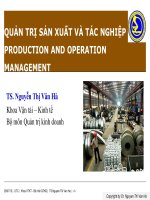Chapter 1: Globalization
Bạn đang xem bản rút gọn của tài liệu. Xem và tải ngay bản đầy đủ của tài liệu tại đây (314.25 KB, 51 trang )
Global Business Today 6e
by Charles W.L. Hill
McGraw-Hill/Irwin
Copyright © 2009 by The McGraw-Hill
Companies, Inc. All rights reserved.
Chapter 1
Globalization
Introduction
In the world economy today, we see
a shift away from self-contained national
economies with high barriers to cross-border
trade and investment
a move toward a more integrated global
economic system with lower barriers to trade
and investment
about $3 trillion in foreign exchange transactions
taking place everyday
over $12 million of goods and some $3 trillion of
services being sold across national borders
the establishment of international institutions
1-3
Introduction
The effects of this trend can be seen
in the cars people drive
in the food people eat
in the jobs where people work
in the clothes people wear
in many other ways
1-4
What Is Globalization?
Question: What is globalization?
Globalization refers to the trend towards
a more integrated global economic
system
Two key facets of globalization are:
the globalization of markets
the globalization of production
1-5
Classroom Performance System
The trend away from distinct national
economic units and toward one huge
global market is known as
a) Internationalization
b) Economic integration
c) Globalization
d) Privatization
1-6
The Globalization of Markets
The globalization of markets refers to the
merging of historically distinct and
separate national markets into one huge
global marketplace
In many markets today, the tastes and
preferences of consumers in different
nations are converging upon some global
norm
Examples of this trend include Coca
Cola, Starbucks, Sony PlayStation, and
McDonald’s hamburgers
1-7
The Globalization of Production
The globalization of production refers to the
sourcing of goods and services from locations
around the globe to take advantage of national
differences in the cost and quality of factors of
production (labor energy, land, and capital)
The goal for companies is to lower their overall
cost structure or improve the quality or
functionality of their product and gain
competitive advantage
Examples of companies doing this include
Boeing and Vizio
1-8
The Emergence
of Global Institutions
Several global institutions have emerged to
help manage, regulate, and police the
global market place
promote the establishment of
multinational treaties to govern the global
business system
1-9
The Emergence
of Global Institutions
Notable global institutions include
the World Trade Organization (WTO)
which is responsible for policing the world
trading system and ensuring that nations
adhere to the rules established in WTO
treaties
In 2008, 151 nations accounting for 97% of
world trade were members of the WTO
the International Monetary Fund (IMF)
which maintains order in the international
monetary system
1-10
The Emergence
of Global Institutions
the World Bank which promotes
economic development
the United Nations (UN) which maintains
international peace and security,
develops friendly relations among
nations, cooperates in solving
international problems and promotes
respect for human rights, and is a center
for harmonizing the actions of nations
1-11
Classroom Performance System
Which of the following is not an example of
a global institution?
a)The Federal Reserve
b)The International Monetary Fund
c)The World Bank
d)The World Trade Organization
1-12
Drivers of Globalization
Question: What is driving the move
toward greater globalization?
There are two macro factors underlying
the trend toward greater globalization
1. declining trade and investment
barriers
2. technological change
1-13
Classroom Performance System
Coca-Cola, Sony Playstations, and
McDonald’s hamburgers are all examples
of
a) American products
b) Global products
c) Industrial products
d) National products
1-14
Declining Trade
and Investment Barriers
International trade occurs when a firm
exports goods or services to consumers
in another country
Foreign direct investment (FDI) occurs
when a firm invests resources in business
activities outside its home country
During the 1920s and 1930s, many
nations erected barriers to international
trade and FDI to protect domestic
industries from foreign competition
1-15
Declining Trade
and Investment Barriers
After WWII, advanced Western countries began
removing trade and investment barriers
Under GATT (the forerunner of the WTO), over
100 nations negotiated further decreases in
tariffs and made significant progress on a
number of non-tariff issues
Under the WTO, a mechanism now exists for
dispute resolution and the enforcement of trade
laws, and there is a push to cut tariffs on
industrial goods, services, and agricultural
products
1-16
Declining Trade
and Investment Barriers
Lower trade barriers enable companies
to view the world as a single market and
establish production activities in optimal
locations around the globe
This has led to an acceleration in the
volume of world trade and investment
since the early 1980s
1-17
Declining Trade
and Investment Barriers
Growth in World Merchandise Trade and
Production, 1950 - 2006
1-18
Classroom Performance System
Which organization provides a mechanism
for dispute resolution and the enforcement
of trade laws?
a) The UN
b) The IMF
c) The WTO
d) The World Bank
1-19
The Role of
Technological Change
The lowering of trade barriers made
globalization of markets and production a
theoretical possibility, technological
change made it a tangible reality
Since World War II, there have been
major advances in communication,
information processing, and
transportation
1-20
The Role of
Technological Change
The development of the microprocessor has
lowered the cost of global communication and
therefore the cost of coordinating and controlling
a global organization
Web-based transactions have grown from
virtually zero in 1994 to $250 billion in 2007 in the
U.S. alone, and Internet usage is up from fewer
than 1 million users in 1990 to 1.3 billion users in
2007
Commercial jet aircraft and super freighters and
the introduction of containerization have greatly
simplified trans-shipment from one mode of
transport to another
1-21
The Role of
Technological Change
Question: What are the implications of
technological change for the globalization
of production?
Lower transportation costs make a
geographically dispersed production
system more economical and allow firms
to better respond to international
customer demands
1-22
The Role of
Technological Change
Question: What are the implications of
technological change for the globalization of
markets?
Low cost communications networks have helped
create electronic global marketplaces
Low cost transportation have enabled firms to
create global markets, and have facilitated the
movement of people from country to country
promoting a convergence of consumer tastes
and preferences
1-23
The Changing Demographics
of the Global Economy
In the 1960s:
the U.S. dominated the world economy
and the world trade picture
the U.S. dominated world FDI
U.S. multinationals dominated the
international business scene
about half the world-- the centrally
planned economies of the communist
world-- was off limits to Western
international business
Today, much of this has changed.
1-24
The Changing World Output
and World Trade Picture
In the early 1960s, the U.S. was the
world's dominant industrial power
accounting for about 40.3% of world
manufacturing output
By 2007, the U.S. accounted for only
20.7%
Other developed nations experienced a
similar decline
1-25









